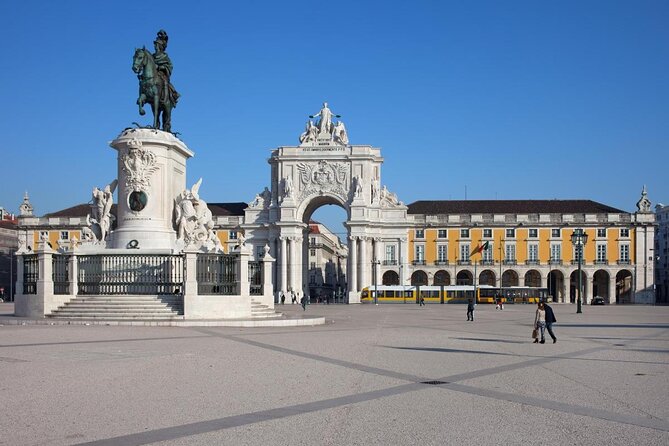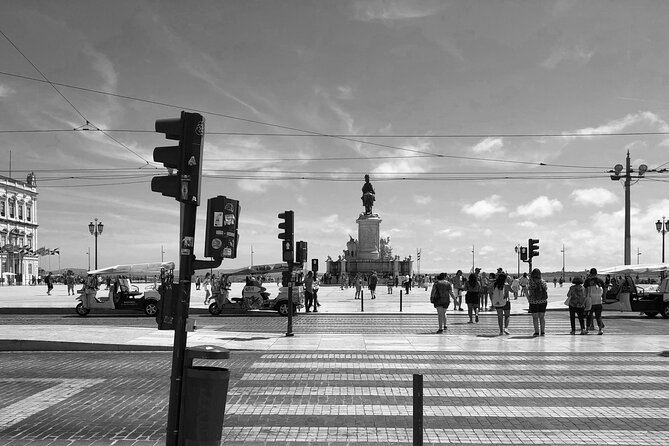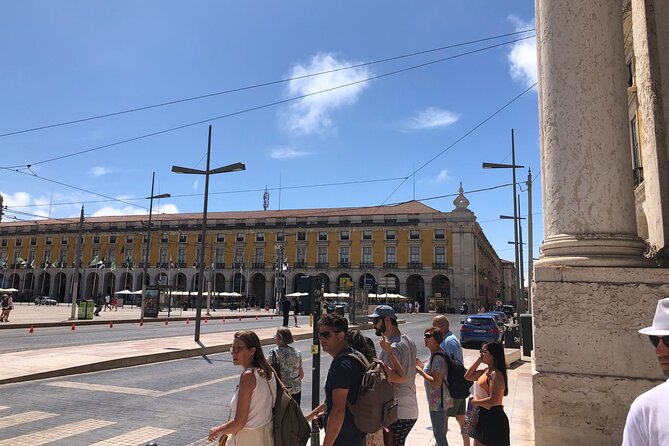In the heart of Lisbon, the Autos-da-Fé unfolded as a chilling blend of theater and terror, transforming the grim realities of the Inquisition into public spectacles that captivated and horrified. Crowds gathered, eager to witness the fate of those accused, their collective breath held as the accused faced an unyielding system. These events not only reinforced the Church’s power but also echoed in the hearts of the people, reminding them of the dire consequences of dissent. What motivated this theatricality, and how did it shape the cultural landscape of Portugal? The answers lie in the grim performances that defined an era.
Key Points

- Autos-da-Fé were public spectacles that reinforced Church authority and instilled fear within the populace through dramatic performances of religious persecution.
- The trials resembled theatrical performances, with defined roles creating heightened tension and visible fear among the accused.
- Rituals and chants during the proceedings contributed to a haunting atmosphere, making the trials memorable for the audience.
- Significant locations in Lisbon, like Teatro Nacional Dona Maria II, echo the historical context of the Inquisition and its theatrical nature.
- The cultural impact of the Autos-da-Fé continues to inspire discussions about tolerance, identity, and the legacy of persecution in literature and art.
Historical Context of the Inquisition

Throughout the late 15th and early 16th centuries, the Inquisition emerged as a powerful force in Europe, particularly in Portugal and Spain. This religious tribunal sought to maintain Catholic orthodoxy during a time of significant societal change.
As the Protestant Reformation gained momentum, fears of heresy intensified, prompting the Church to take drastic measures. The Spanish and Portuguese monarchies, eager to consolidate power and unify their realms, supported the Inquisition wholeheartedly.
They targeted not just Jews and Muslims, but also any dissenters challenging the Church’s authority. Torture and public trials became commonplace, instilling fear among the populace.
The Inquisition’s grip on society forged a chilling atmosphere where loyalty to the Church dictated one’s fate, setting the stage for dramatic events like the infamous autos-da-fé.
You can also read our reviews of more tours and experiences in Lisbon.
The Significance of Autos-da-Fé

The autos-da-fé, or acts of faith, played a crucial role in the spectacle of the Inquisition, transforming religious persecution into a public performance that captivated and terrified society.
These events served not only as a means for the Church to assert its authority but also as a way to reinforce social order through fear. Crowds gathered to witness the dramatic proceedings, where the accused faced their fates, often involving public humiliation or execution.
This theatricality magnified the impact of the Inquisition, shaping public perception and deterring dissent. By framing these brutal acts as moral lessons, the Church aimed to unify the populace under a shared belief system, solidifying its grip on power and instilling a lasting sense of caution among the people.
The Role of Theatricality in Trials
Witnessing the trials of the Inquisition was like stepping into a dramatic performance, where every participant played a role in a chilling spectacle.
The accused stood at the center, often trembling, as the inquisitors, donned in their somber robes, orchestrated the proceedings with an air of authority.
The audience, packed with onlookers, eagerly absorbed the tension, heightening the drama of the moment.
Rituals, chants, and vivid proclamations transformed the courtroom into a stage, making the trial a public show of power and fear.
Each element—from the flickering torches to the heavy silence—contributed to a theatrical atmosphere that reinforced the Inquisition’s grip on society.
It wasn’t just justice; it was a haunting performance meant to instill dread and compliance among the populace.
Key Locations in Lisbon

Lisbon, a city steeped in history and culture, offers a treasure trove of key locations that reflect its rich past.
The Teatro Nacional Dona Maria II stands as a prominent meeting point, an architectural gem at Rossio, where visitors can start their journey. This elegant building echoes tales of theatrical performances that once captivated audiences.
The tour culminates at Martinho da Arcada, a historic café on Praça do Comércio, where the poet Fernando Pessoa found inspiration. This café not only serves delightful port toasts but also invites guests to enjoy the artistic ambiance that shaped Lisbon’s literary scene.
These locations capture the essence of the city’s historical narrative, intertwining art, culture, and the shadows of its inquisitorial past.
The Experience of Participants
Stepping into the world of the Inquisition, participants find themselves immersed in a narrative that unfolds through captivating storytelling and historical insights. They engage with the past, experiencing the dramatic settings and fierce emotions tied to the Autos-da-Fé.
Each moment is designed to evoke reflection and understanding, transforming history into a living experience.
Key aspects of their experience include:
- Interactive storytelling that brings history to life
- Visits to significant historical locations
- Opportunity to enjoy a port toast at a renowned café
- Engaging dialogues with knowledgeable guides
- Insight into the cultural impact of the Inquisition
Through these elements, participants gain a deeper appreciation for Lisbon’s complex history, making the journey both educational and memorable.
- Lisbon: Half Day Sightseeing Tour on a Private Electric Tuk Tuk
- Alfama Tour in Lisbon Old Town
- Undiscovered Lisbon Food & Wine Tour With Eating Europe
- 2 Hour Lisbon Sunset and Wine Sailing Tour
- Small Group Tour to Sintra, Pena Palace, Pass by Regaleira, Cabo Roca, Cascais
- Lisbon Small-Group Food Tour With 15 Tastings in Alfama District
Accessibility and Practical Information
Many travelers will find that the theatrical path of the Inquisition offers excellent accessibility and practical information to enhance their experience.
The tour starts at the Teatro Nacional Dona Maria II, a stunning building easily reachable via public transportation. It’s wheelchair and stroller accessible, ensuring everyone can join in on the adventure. Service animals are welcome, making it a friendly option for all.
Participants are encouraged to wear comfortable clothing and shoes, as they’ll be exploring vibrant Lisbon. While water should be brought along, a delightful port toast awaits at the historic café where Fernando Pessoa penned his poems.
Plus, with a flexible reservation system, travelers can secure their spot without immediate payment, making planning a breeze.
Reflections on Cultural Impact
The theatrical path of the Inquisition invites participants to explore a rich tapestry of cultural history, illustrating the profound impact of the Autos-da-Fé on Portuguese society.
These events shaped not only the religious landscape but also influenced art, literature, and community values. The lingering effects are evident in various aspects of contemporary culture:
- Theatrical performances inspired by historical narratives
- Literature reflecting themes of persecution and identity
- Architectural remnants of Inquisition-era structures
- Artistic expressions that critique or commemorate the past
- Public discussions on tolerance and cultural heritage
Ask Away
What Should I Wear for the Tour?
For the tour, travelers should wear comfortable clothes and shoes, ensuring they can enjoy the experience fully. It’s essential to dress appropriately, as they’ll be walking and exploring various historical sites throughout the day.
Are Children Allowed to Participate in the Tour?
Children can participate in the tour, but parents should consider the content’s historical depth. The experience’s engaging storytelling makes it suitable for inquisitive minds, fostering a deeper understanding of Portugal’s rich, complex past.
How Long Does the Tour Last?
The tour lasts approximately two hours. Participants stroll through Lisbon’s historical streets, experiencing engaging narratives and rich culture, all while enjoying the vibrant atmosphere. It’s a delightful way to discover the city’s intriguing past.
Is Photography Permitted During the Tour?
During the tour, photography’s generally allowed, but participants should be mindful of the surroundings and respect any restrictions. It’s a chance to capture memorable moments while immersing in the rich history of the experience.
Can I Join the Tour if I Don’t Drink Alcohol?
She can absolutely join the tour even if she doesn’t drink alcohol. The experience focuses on history and culture, and participants are encouraged to enjoy the journey regardless of their beverage preferences.
Final Words
The Autos-da-Fé not only served as a grim reminder of the Inquisition’s power but also transformed the act of persecution into a chilling spectacle that captivated and terrified the public. Through their theatricality, these events reinforced societal norms and instilled a deep-seated fear of dissent. Today, the legacy of the Inquisition continues to shape Portugal’s cultural identity, reminding us of the fine line between faith and fanaticism, and the powerful influence of authority in society.
More Tour Reviews in Lisbon
Not for you? Here's more nearby things to do in Lisbon we have reviewed
- Lisbon: Private Tuk Tuk Tour with Professional Guide
- Lisbon Boat Tour
- Lisbon: Golf Experience with Equipment Rental
- Tuk-Tuk sightseeing in lisbon(Old town)
- Lisbon Half Day Tuk Tuk Tour (Alfama & Belem)
- From Lisbon: Fátima HD and the Three Little Shepherds’ House
- Lisbon: Algarve,Benagil Cave, Lagos & Carvoeiro Private Tour
- Tasting Portugal: Taste and discover the secrets of Port Wine!
- Lisbon Walk: Old Quarter, Hidden Walls & Stunning Views
- Lisbon: Boat trip Lunch on board with open bar
- Walk Lisbon Like a Local: Bairro Alto & Downtown Experience
- Lisbon: Bachelorette Party Photoshoot Tour
